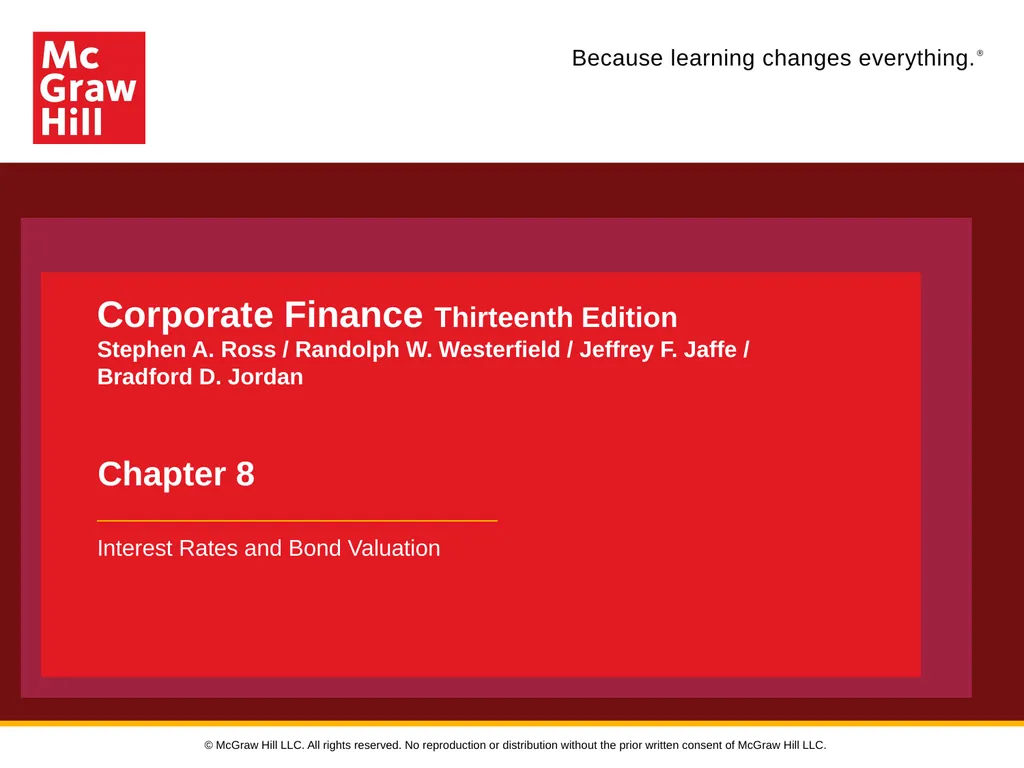Corporate Finance Thirteenth Edition Stephen A.
Author : alexa-scheidler | Published Date : 2025-05-16
Description: Corporate Finance Thirteenth Edition Stephen A Ross Randolph W Westerfield Jeffrey F Jaffe Bradford D Jordan Chapter 8 Interest Rates and Bond Valuation McGraw Hill LLC All rights reserved No reproduction or distribution
Presentation Embed Code
Download Presentation
Download
Presentation The PPT/PDF document
"Corporate Finance Thirteenth Edition Stephen A." is the property of its rightful owner.
Permission is granted to download and print the materials on this website for personal, non-commercial use only,
and to display it on your personal computer provided you do not modify the materials and that you retain all
copyright notices contained in the materials. By downloading content from our website, you accept the terms of
this agreement.
Transcript:Corporate Finance Thirteenth Edition Stephen A.:
Corporate Finance Thirteenth Edition Stephen A. Ross / Randolph W. Westerfield / Jeffrey F. Jaffe / Bradford D. Jordan Chapter 8 Interest Rates and Bond Valuation © McGraw Hill LLC. All rights reserved. No reproduction or distribution without the prior written consent of McGraw Hill LLC. Key Concepts and Skills Know the important bond features and bond types. Understand bond values and why they fluctuate. Understand bond ratings and what they mean. Understand the impact of inflation on interest rates. Understand the term structure of interest rates and the determinants of bond yields. 2 Chapter Outline 8.1 Bonds and Bond Valuation 8.2 Government and Corporate Bonds 8.3 Bond Markets 8.4 Inflation and Interest Rates 8.5 Determinants of Bond Yields 3 8.1 Bonds and Bond Valuation A bond is a legally binding agreement between a borrower and a lender that specifies the: Par (face) value. Coupon rate. Coupon payment. Maturity date. The yield to maturity is the required market interest rate on the bond. 4 Bond Valuation Primary Principle: Value of financial securities = PV of expected future cash flows. Bond value is, therefore, determined by the present value of the coupon payments and par value. Interest rates are inversely related to present values (i.e., bond prices). 5 The Bond-Pricing Equation Bond value = Present value of the coupons + Present value of the face amount 6 Bond Example - I Consider a U.S. government bond with as 6.375 percent coupon that expires in December 2025. The par value of the bond is $1,000. Coupon payments are made semiannually (June 30 and December 31 for this particular bond). Since the coupon rate is 6.375 percent, the semiannual payment is $31.875. On January 1, 2021, the size and timing of cash flows are: Access the text alternative for slide images 7 Bond Example – II On January 1, 2021, the required yield is 5 percent. The current value is: 8 Bond Example: Calculator Find the present value (as of January 1, 2021) of a 6.375 percent coupon bond with semiannual payments and a maturity date of December 2025 if the YTM is 5 percent. Access the text alternative for slide images 9 Bond Example: Price Change Now assume that the required yield is 11 percent. How does this change the bond’s price? 10 Y T M and Bond Value When the Y T M > coupon, the bond trades at a discount.














